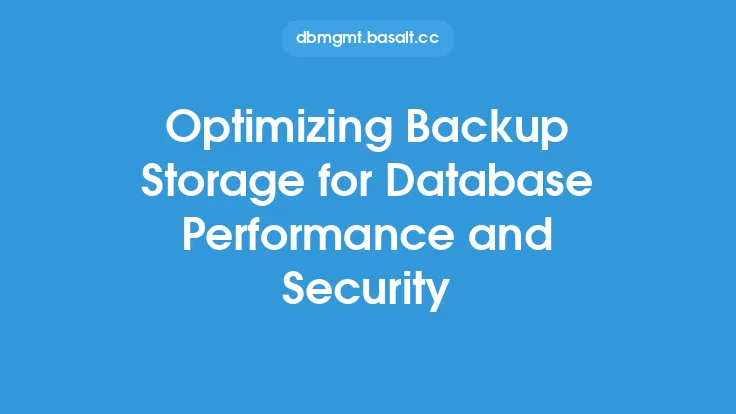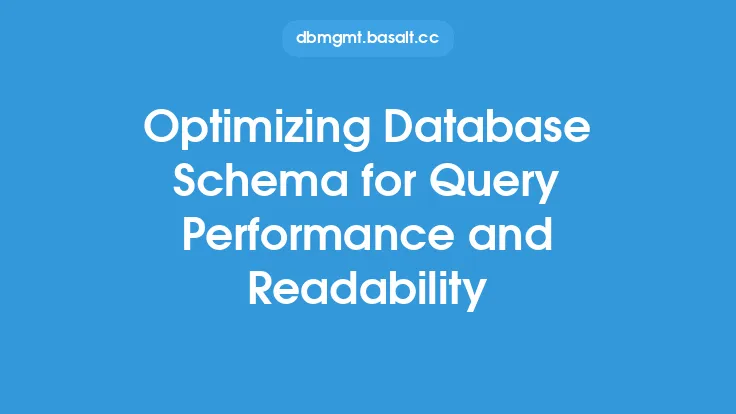Database authentication is a critical component of database security, as it ensures that only authorized users can access and manipulate the data stored in the database. Optimizing database authentication for performance and security is essential to prevent unauthorized access, data breaches, and other security threats. In this article, we will delve into the details of optimizing database authentication for performance and security, exploring the various techniques, best practices, and technologies that can be employed to achieve this goal.
Introduction to Database Authentication Optimization
Database authentication optimization involves a combination of techniques and strategies aimed at improving the performance and security of the authentication process. This includes optimizing the authentication protocol, reducing the number of authentication requests, and implementing secure authentication mechanisms. By optimizing database authentication, organizations can reduce the risk of security breaches, improve user experience, and increase overall system performance.
Understanding Authentication Protocols
Authentication protocols play a crucial role in database authentication optimization. Common authentication protocols used in databases include SQL Server Authentication, Kerberos, and LDAP. Each protocol has its strengths and weaknesses, and the choice of protocol depends on the specific requirements of the organization. For example, SQL Server Authentication is a simple and widely supported protocol, but it may not provide the same level of security as Kerberos or LDAP. Understanding the different authentication protocols and their characteristics is essential for optimizing database authentication.
Optimizing Authentication Performance
Optimizing authentication performance involves reducing the time it takes for users to authenticate and access the database. This can be achieved through various techniques, such as caching authentication credentials, reducing the number of authentication requests, and optimizing database queries. Caching authentication credentials can reduce the number of authentication requests made to the database, resulting in improved performance. Additionally, optimizing database queries can reduce the time it takes to authenticate users and retrieve data.
Implementing Secure Authentication Mechanisms
Implementing secure authentication mechanisms is critical for optimizing database authentication for security. This includes using secure authentication protocols, such as SSL/TLS, and implementing additional security measures, such as encryption and access controls. Encryption can protect authentication credentials and data in transit, while access controls can restrict access to sensitive data and prevent unauthorized access. Additionally, implementing secure password storage and management practices, such as password hashing and salting, can further enhance security.
Using Database Authentication Tools and Technologies
Various tools and technologies are available to optimize database authentication for performance and security. These include database authentication software, such as Oracle Advanced Security and Microsoft SQL Server Security, and authentication frameworks, such as OpenID Connect and OAuth. These tools and technologies can provide additional security features, such as multi-factor authentication and single sign-on, and can help optimize authentication performance. Additionally, using cloud-based authentication services, such as Amazon Web Services (AWS) Identity and Access Management (IAM), can provide scalable and secure authentication solutions.
Best Practices for Database Authentication Optimization
Best practices play a critical role in optimizing database authentication for performance and security. These include regularly reviewing and updating authentication protocols and mechanisms, monitoring authentication activity, and implementing secure password management practices. Additionally, using secure communication protocols, such as HTTPS, and encrypting data in transit can further enhance security. Regularly testing and evaluating authentication mechanisms can also help identify vulnerabilities and optimize performance.
Common Challenges and Solutions
Optimizing database authentication for performance and security can be challenging, and various obstacles may arise. Common challenges include balancing security and performance, managing complex authentication protocols, and ensuring compatibility with different database systems. Solutions to these challenges include using authentication frameworks and tools, implementing secure authentication mechanisms, and regularly monitoring and evaluating authentication activity. Additionally, using cloud-based authentication services can provide scalable and secure authentication solutions, while outsourcing authentication to third-party providers can help reduce complexity and improve security.
Future of Database Authentication Optimization
The future of database authentication optimization is likely to involve the use of advanced technologies, such as artificial intelligence (AI) and machine learning (ML), to improve security and performance. These technologies can help detect and prevent security threats, optimize authentication protocols, and improve user experience. Additionally, the use of cloud-based authentication services and authentication frameworks is likely to increase, providing scalable and secure authentication solutions. As database security threats continue to evolve, optimizing database authentication for performance and security will remain a critical component of overall database security strategy.
Conclusion
Optimizing database authentication for performance and security is essential for preventing unauthorized access, data breaches, and other security threats. By understanding authentication protocols, optimizing authentication performance, implementing secure authentication mechanisms, and using database authentication tools and technologies, organizations can improve the security and performance of their database systems. Best practices, such as regularly reviewing and updating authentication protocols and mechanisms, monitoring authentication activity, and implementing secure password management practices, can also help optimize database authentication. As database security threats continue to evolve, staying informed about the latest technologies and best practices will be critical for optimizing database authentication for performance and security.





